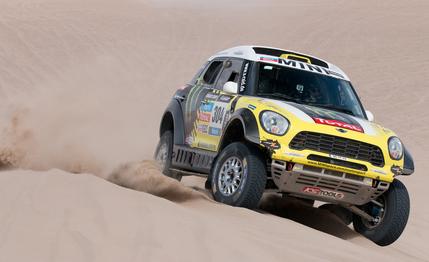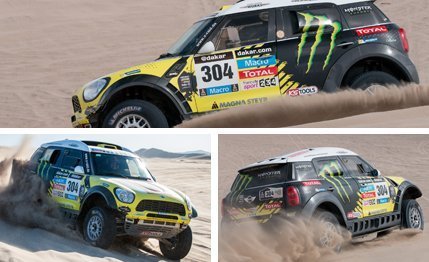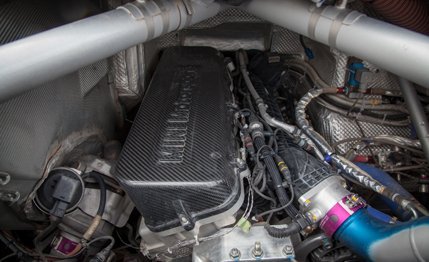 First Drive Review
First Drive Review
In the rich-guy meeting of the imagination, where those of high net worth get together to compare all their million-dollar toys, you’d get some strange looks by showing up in a Mini ALL4 Racing.
“How can a Mini be worth a million bucks?” demand the folks with yachts and airplanes and Veyrons.
“It’s not really a Mini,” says you, “any more than your 501(c)(3)s are charities. And it’s not really a million bucks, it’s a million euros, which is more like 1.4 million bucks.”
“But what does it do?” they ask.
“It can run,” you reply, “at over 130 mph across sand and rock and rough road for up to 500 miles on a single 95-gallon fill-up of pump diesel while you sit in air-conditioned comfort enjoying power steering, water-cooled brakes, three lockable differentials, and almost eight inches of suspension travel. If you blow a tire, it’s no problem; there are three spares on board and an onboard hydraulic jack system that can have you going again in under three minutes.”

“Oooh,” they say in unison, “we didn’t even know it existed five minutes ago, but now we must have one.”
Like all top-shelf rally racers, the Mini ALL4 Racing doesn’t have much in common with the production car it resembles—in this case the Mini Countryman, currently the brand’s second-bestselling model after the Cooper hardtop. In fact, the windshield, the door handles, taillights, and Mini badges are production parts, while the rest is hand-fabricated, autoclaved, tweaked, and twiddled at workshops in France and Germany.
It all comes together at the shop of X-Raid GmbH near Frankfurt. The race shop, opened in 2002 to build cars for rallying and Dakar-type cross-country events, is run by Sven Quandt and his two sons, Thomas and Tobias, all relatives of BMW’s controlling family. Seeing the connections?
This 4200-pound “Mini” is actually a tubular-steel frame sheathed in carbon-fiber panels and packed to the rafters with a 3.0-liter BMW inline-six diesel making 300 horsepower and 516 lb-ft of torque, a six-speed sequential manual gearbox, countless radiators and reservoir bottles and things that look like mobile kidney-dialysis machines, plus more unidentifiable hardware than the Apollo lunar module.
Which is a fitting metaphor because out among the desolate peaks and dunes of Chile’s wild Atacama Desert, where this particular Mini ALL4 Racing recently bounded to victory in the 2014 Dakar Rally, the car’s two-man crew were at times almost as isolated as those who trod the lunar regolith. Which means they needed some serious kit to get by.
Motoring the Mega-Mini
To demonstrate this mega-Mini’s immense capabilities, the company invited us to turn a few miles behind the wheel in a reasonable local facsimile of the Atacama’s emptiness, the Dumont Dunes in Death Valley National Park. Out there, it can go from dead still to a 30-mph blow in two eye blinks, the sand whipped up and turned into a vicious horizontal force of gritty destruction as it streams off the tips of the dune peaks like scenes from the dreams of T.E. Lawrence.

The ALL4 Racing is like an 11/10ths scale model of the production car, being about nine inches longer, eight inches wider, and 16 inches taller than the retail version. After donning a race suit and an open, motocross-style helmet, you remove the steering wheel, climb up on the sill, stick your right foot into the pedal box, grab the rollover bar for support, swing your butt into the seat, haul in your left leg, and reattach the wheel.
My co-driver and instructor, winning Dakar navigator Michel Perin of France, who will happily show you the scars from a shattered forearm suffered in a rally crash a few years ago, plugs in the helmet communicator and suddenly he’s in my ear. All serious race cars have radio communication, and this is a serious race car.
The carbon-fiber dash is awash with switches, stalks, and buttons, but you soon realize that, like the lunar lander, most of them are caps for fuses and the important controls are labeled and fairly obvious: starter, hazards, turn signals, differential locks, air conditioning, etc. A few less obvious ones do things like page the multicolor display screen through its various menus and readouts, which can tell you such esoteric information as the fluid temperatures inside each individual shock absorber. Another switch controls the transmission’s shift modes. The driver can operate the tall sequential shifter either with or without the clutch pedal, though no matter what, he or she needs to use the clutch to move from rest.